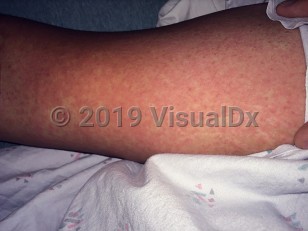Zika virus infection in Child
Alerts and Notices
Important News & Links
Synopsis

Zika virus is a mosquito-borne single-stranded RNA virus of the Flaviviridae family, closely related to the dengue virus. Human infection is primarily acquired via bites from infected Aedes aegypti or Aedes albopictus mosquitoes in endemic areas: the tropical regions of Africa, Southeast Asia, the South Pacific islands, and more recently, the Americas. In 2015, a Zika virus outbreak was first reported in Brazil, Colombia, and Suriname. Travel-related cases have since been reported in the United States; sexually transmitted cases are suspected to have occurred, and Zika virus has been found in the semen of infected men. Viral shedding has also been documented in vaginal secretions of infected women. A small number of cases of likely local mosquito-borne Zika virus transmission have been reported in Miami, Florida, and Brownsville, Texas. Since late 2016, Zika virus transmission in the Americas has dropped significantly. There have been rare cases of person-to-person nonsexual transmission. There is no apparent sex or age predilection for Zika virus infection.
Twenty to twenty-five percent of patients infected with Zika virus develop clinical manifestations. After being bitten by an infected mosquito, it takes approximately 3-14 days for symptoms to appear. The diagnostic criteria of Zika virus disease include a widespread erythematous macular and papular rash (involving the face, trunk, extremities, palms, and/or soles) and at least one of the following manifestations: fever, arthralgia, arthritis, and/or conjunctivitis. Other symptoms may include myalgias, headache, sore throat, cough, vomiting, and diarrhea.
Symptoms are typically mild, short-lasting (2-7 days), and self-limited. In a 2019 review, rash was seen in 90% of 240 cases. Mucocutaneous hemorrhage occurred in approximately 8% of individuals, and conjunctivitis was seen in just over one-third of individuals. Zika viral infection in pregnant patients has been associated with microcephaly in infants (see congenital Zika virus infection). There are also cases of fetal loss in women who were infected with Zika virus. It is thought that these outcomes are the result of congenital infection with Zika virus. Additionally, Guillain-Barré syndrome and other neurological disorders have been reported in patients after exposure to Zika virus.
Because the clinical presentation overlaps with those of other arboviruses, such as dengue fever and chikungunya, cases may be mistaken for another arboviral infection.
Zika virus has the potential to cause outbreaks, but cases in travelers returning to nonendemic areas are infrequently reported. While Zika virus is spread by the bite of an infected mosquito, there have been reports of it being spread human to human via sexual transmission as well as via blood transfusion.
Twenty to twenty-five percent of patients infected with Zika virus develop clinical manifestations. After being bitten by an infected mosquito, it takes approximately 3-14 days for symptoms to appear. The diagnostic criteria of Zika virus disease include a widespread erythematous macular and papular rash (involving the face, trunk, extremities, palms, and/or soles) and at least one of the following manifestations: fever, arthralgia, arthritis, and/or conjunctivitis. Other symptoms may include myalgias, headache, sore throat, cough, vomiting, and diarrhea.
Symptoms are typically mild, short-lasting (2-7 days), and self-limited. In a 2019 review, rash was seen in 90% of 240 cases. Mucocutaneous hemorrhage occurred in approximately 8% of individuals, and conjunctivitis was seen in just over one-third of individuals. Zika viral infection in pregnant patients has been associated with microcephaly in infants (see congenital Zika virus infection). There are also cases of fetal loss in women who were infected with Zika virus. It is thought that these outcomes are the result of congenital infection with Zika virus. Additionally, Guillain-Barré syndrome and other neurological disorders have been reported in patients after exposure to Zika virus.
Because the clinical presentation overlaps with those of other arboviruses, such as dengue fever and chikungunya, cases may be mistaken for another arboviral infection.
Zika virus has the potential to cause outbreaks, but cases in travelers returning to nonendemic areas are infrequently reported. While Zika virus is spread by the bite of an infected mosquito, there have been reports of it being spread human to human via sexual transmission as well as via blood transfusion.
Codes
ICD10CM:
A92.8 – Other specified mosquito-borne viral fevers
SNOMEDCT:
3928002 – Zika virus disease
A92.8 – Other specified mosquito-borne viral fevers
SNOMEDCT:
3928002 – Zika virus disease
Look For
Subscription Required
Diagnostic Pearls
Subscription Required
Differential Diagnosis & Pitfalls

To perform a comparison, select diagnoses from the classic differential
Subscription Required
Best Tests
Subscription Required
Management Pearls
Subscription Required
Therapy
Subscription Required
References
Subscription Required
Last Reviewed:11/19/2022
Last Updated:01/04/2023
Last Updated:01/04/2023
 Patient Information for Zika virus infection in Child
Patient Information for Zika virus infection in Child
Premium Feature
VisualDx Patient Handouts
Available in the Elite package
- Improve treatment compliance
- Reduce after-hours questions
- Increase patient engagement and satisfaction
- Written in clear, easy-to-understand language. No confusing jargon.
- Available in English and Spanish
- Print out or email directly to your patient
Upgrade Today


